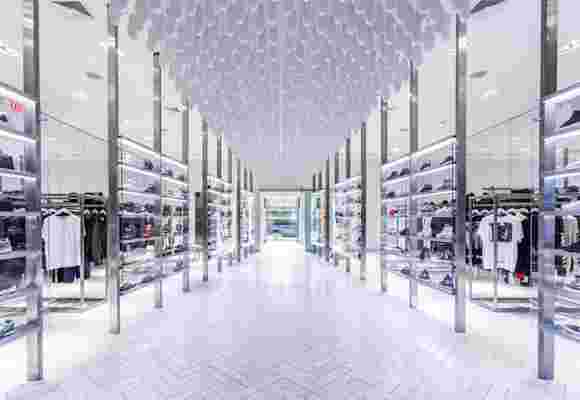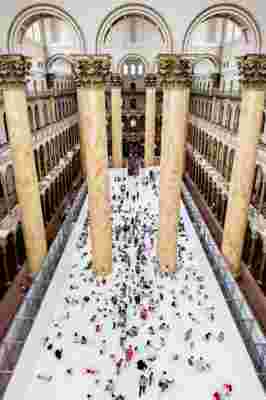Snarkitecture on the Value of Monochromatic Spaces, Art and Architecture, and Kanye West
If you follow anyone on Instagram who’s visited the Washington, D.C., or Tampa area in the past year, you may have seen work by Snarkitecture flooding your feed. The New York studio’s positively viral ball-pit installation The Beach —first staged at the National Building Museum in D.C. in 2015 and now traveling around the country—is emblematic of Snarkitecture’s propensity for using such common materials such as scaffolding, paneling, and mirrors to build something extraordinary. The experimental art-and-architecture firm takes its name from a Lewis Carroll poem, and lets the setting they work in—the color of the sky, a neon sign, a particular texture—influence the outcome. We caught up with the studio, one of our Readers‘ Choice Innovators, and asked them about everything from the importance of art and architecture as one to how Kanye West inspires them.
Architectural Digest : What is the firm’s design philosophy?
Snarkitecture: To make architecture perform the unexpected.
AD : What is Snarkitecture’s most innovative project to date and why?
S: Every project is valuable for its own reasons. We look to create memorable moments at a range of scales, from a small object like the Secret Souvenir candle, to a massive installation like The Beach , or a permanent space like the Kith retail flagship in Brooklyn. The most successful Snarkitecture projects often use the simplest approach to create memorable experiences.
AD : Tell us about some of your upcoming projects and what you’re most excited about.
S: The studio is busy working on a number of new projects, ranging from retail to residential to public installations to object collaborations. The announced projects include a new Kith store in Miami this winter, an installation for ComplexCon in Los Angeles in November, and a new limited-edition piece with 1882 Ltd., releasing in September. There are also many projects that aren’t public yet, including the next location of The Beach .

Kith's Brooklyn store.
AD : How do you see art and architecture working together?
S: We established Snarkitecture with the intention of exploring that undefined territory that exists between these disciplines. Within our own practice, we’re less interested in separating or defining the differences. In the way that our work engages with the world at large, there’s value for us in the flexibility of working toward either side of the spectrum.
AD : What has been your biggest inspiration for projects both large and small?
S: We often look toward the familiar—the everyday—whether it’s the architecture that surrounds us or the objects we use on a daily basis. We’re interested in how we can reinterpret these materials, structures, and programs to create new meaning. In transforming the familiar into the unexpected, we want to invite viewers to engage and interact with our objects and spaces in ways that are outside of the everyday, in ways that are transformative and memorable.

Another view of The Beach .
AD : A lot of your projects are white. What is the reasoning behind that choice?
S: The use of monochrome is connected to the concept of reduction—the stripping away of extraneous elements that surround us in our day-to-day environment. It’s less about focusing on the design and more about allowing people to be more attuned to their own surroundings and experience through the reduction of color, material, texture, etc. The work that is all white or uses a monochromatic palette is often inspired by what is already there, whether that’s the white of a wall, the blue of the sky, or the orange in the former Miami Orange Bowl sign.
AD : Creatively, who do you look to as an innovator in your field?
S: We’re more often looking outside of our fields, or to the past—and future—for inspiration and innovation. At the moment, the stage design for Kanye West’s “Saint Pablo” tour is one of the latest and more memorable examples of innovation.
Related: See More AD Innovators